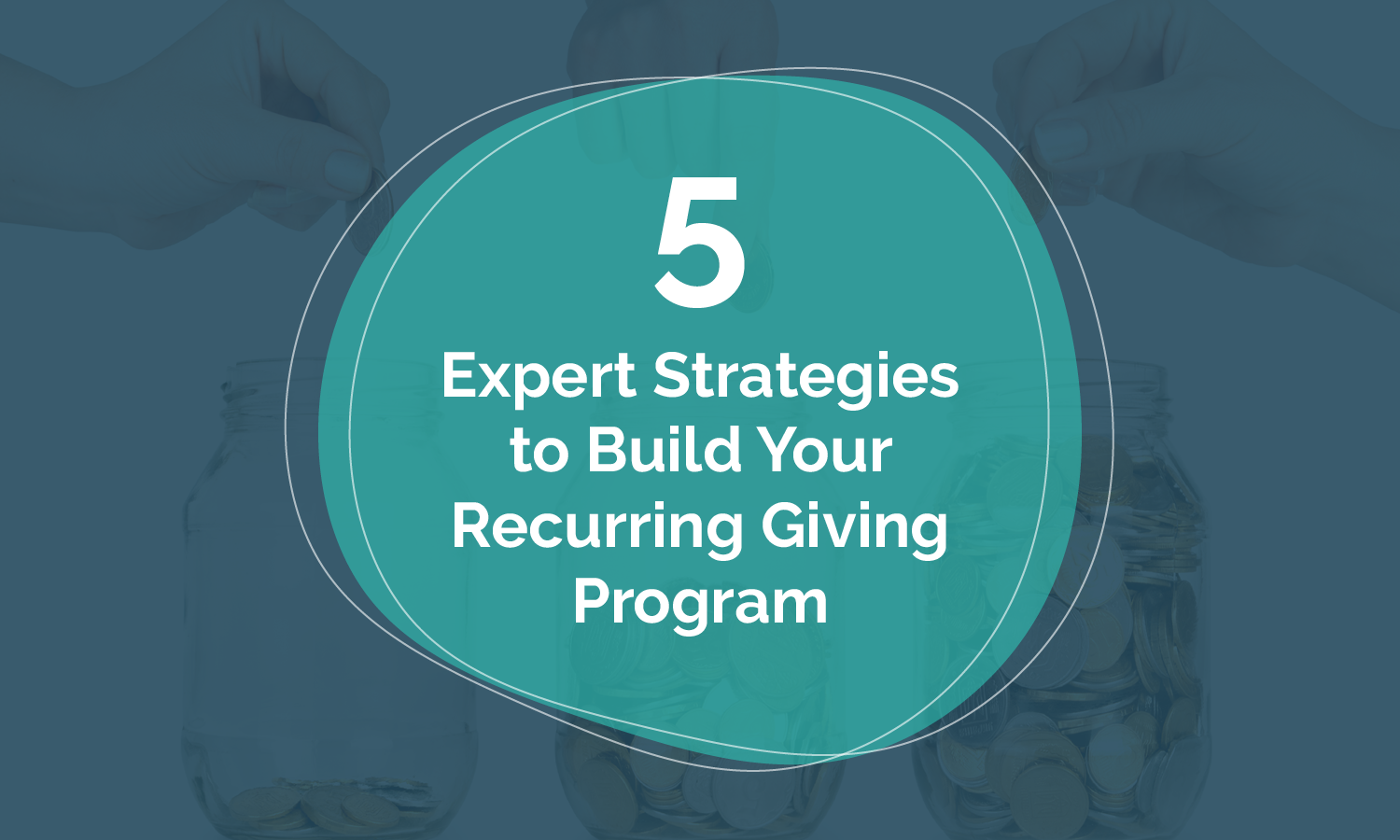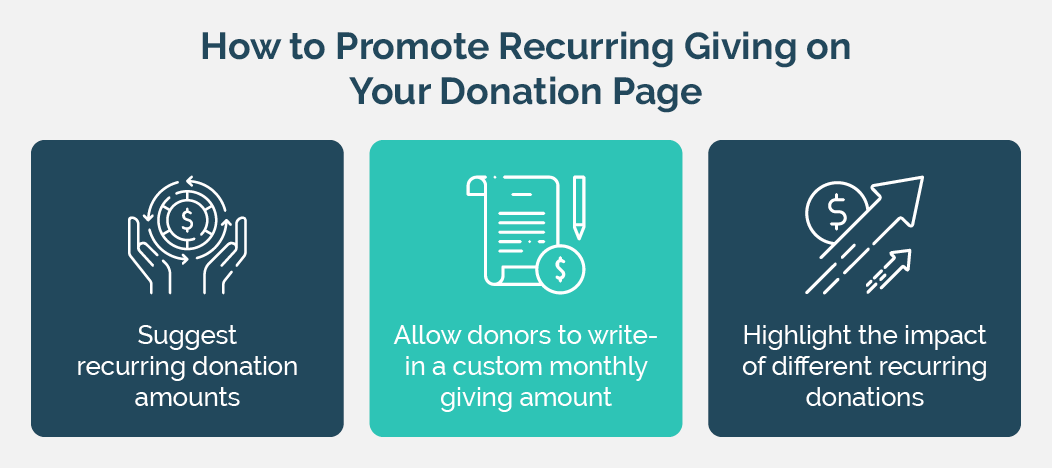
As a nonprofit professional, you understand the importance of establishing a predictable revenue stream. Whether your organization is navigating a particularly tough fundraising season or needs additional funds to cover your essential community programs, a regular influx of donations can make a huge difference in your nonprofit’s ability to reach its goals.
This is where a recurring giving program becomes an essential tool to add to your fundraising toolkit. With a reliable pool of repeat donations, your nonprofit will be in much better shape to tackle obstacles, meet its fundraising objectives, and move your mission forward.
In this guide, we’ll explore the basics of recurring giving and how your organization can boost its donor retention rate, leading to increased financial stability and the ability to make a more significant impact on the community.
The Value of Recurring Giving
Creating a recurring giving program may take ample time and planning, but it’s well worth your efforts. Double the Donation’s guide to donor retention identifies the following inherent benefits of prioritizing monthly giving in your fundraising strategy:
- Access to a consistent revenue stream: Backed by a regular flow of donations, you can stress less about acute expenses and save funds for big-picture projects, programs, and other key initiatives.
- More revenue year-round: While recurring donors tend to give smaller gift amounts on a per-donation basis, these donations quickly add up over the year to be greater than a typical one-time gift. In fact, studies have found that donors who give on a recurring basis give 42% more annually, compared to those who contribute one-time donations.
- Cost-effective: Rather than investing in costly digital ads or email appends to grow your reach and hope that some donors give for the first time, your nonprofit can nurture relationships with donors who already have an interest in your organization and ask them to increase gift amounts gradually. For example, asking donors to increase their recurring gift amount from $10 to $15 a month makes the difference of $60 more each year!
Now that you understand how a recurring giving program can transform your fundraising plan, let’s jump into the top strategies for encouraging repeat donations at your organization.
Strategy #1: Work With an Expert Fundraising Platform
To start building your recurring giving program, you’ll need an expert fundraising platform that will streamline the entire process. Specifically, your software solution should make it simple to target recurring giving candidates, encourage them to sign up for recurring giving, promote regular increases in their giving amount, and motivate them to give year after year.
Look for these features in a fundraising platform:
- One-click sustainer upsells and upgrades so your nonprofit can easily prompt donors to sign up for recurring giving or increase their existing recurring donation amount.
- Personalized donation forms to create a user-friendly donation experience where donors can sign up for recurring giving.
- Targeted communications to send personalized donation appeals to recurring giving candidates and to your existing recurring donors.
- Unique donor portals that enable donors to manage their giving, such as updating their billing address, credit card number, or donation amount.
- Social sharing so your nonprofit can expand the visibility of its recurring giving program.
It can also be helpful to invest in a fundraising platform that doubles as advocacy software, especially if your organization often leads advocacy campaigns to spearhead change in your community. This way, you can encourage supporters to not only get more involved in giving but also in pushing forward change in your community by participating in activities like emailing representatives or signing petitions.
With these comprehensive tools, your nonprofit can make recurring giving a staple in your fundraising strategy. Let’s dive deeper into how you can turn your goals into actionable strategies that boost donor retention.
Strategy #2: Add a Monthly Giving Option to Your Donation Forms
With the help of your fundraising platform, your organization can easily add a monthly giving option to your donation forms. This makes it easy for donors to fill out their donation information just once, rather than having to fill out your form each time they want to give.
To promote your recurring giving option on your donation form, follow these best practices:

- Suggest donation amounts. Give donors suggestions on how much they should contribute on a monthly basis, such as $15, $20, and $25. This can prompt donors to voluntarily give more than they originally intended. If you’re not sure what amounts your organization should suggest, look at your CRM to see the average or most common monthly donation amount to get a better idea of how much your donors are willing and able to give.
- Allow donors to write in a custom amount. In addition to allowing donors to easily click on a suggested donation amount, you should also enable an option to write in their own recurring giving amount and choose how often they want to donate (whether on a bimonthly, monthly, or every-other-month basis.) This allows donors of varying budgets to contribute to your recurring giving program—and even give more than your suggested amounts!
- Highlight the impact of different amounts. To help donors understand the tangible connection between recurring donations and their impact, you can highlight how your suggested donation amounts make a difference. For example, an animal shelter might explain that a contribution of $20 can provide food for 10 cats each month.
To help donors from any device sign up for recurring giving, you should also mobile-optimize your donation page. This way, donors can give conveniently from anywhere—as long as they have their phone in hand. Mobile users made up 33% of online donation transactions last year, so a mobile-optimized form can accelerate your fundraising efforts.
Strategy #3: Send Targeted Donor Communications
Your donors are an invaluable part of your organization’s mission and this should be reflected in your communications. Rather than sending generic messages to all supporters at mass, your organization should use segmentation and send highly personalized communications. This way, your donation appeals and messages are tailored to the recipients, making it more likely that donors will feel inspired and act on your request.
Effective donation appeals should include the following elements:
- Salutation with the donor’s preferred name
- Recognition of their last donation or involvement in your organization
- The specific impact of their contributions
- A sustainer upsell request that makes sense based on the donors’ giving history
Jackson River’s guide to Salesforce donation apps recommends investing in a fundraising tool with native integration with Salesforce so you can track data and generate real-time insights into donor behavior. Plus, with Salesforce, you can automatically send donation appeals to supporters with the right messaging at the right time when they’re most likely to convert.
Strategy #4: Give Each Supporter a Unique Donor Portal
With the ability to manage their giving, supporters will be more likely to trust your organization. Offer donors powerful self-service options like the ability to:
- View their recurring gift details and upcoming payments
- Skip a payment
- Update payment amount or credit card number
- Cancel their recurring gift
- Receive receipts for any gift in Salesforce
This transparency leads to an increase in donations and makes it easier than ever for supporters to upgrade their recurring gifts.
Strategy #5: Promote Your Recurring Giving Program on Social Media
One of the best ways to boost your recurring giving program is by leading a social media marketing campaign. Social media can help your organization connect with existing supporters and introduce new supporters to the rewarding role they can play as recurring donors. To highlight your recurring giving program and increase visibility, follow these steps:
- Share your donation page on popular platforms like Instagram and Facebook
- Include instructions on how to sign up for recurring giving
- Describe the positive community impacts that come from contributing regularly
With the right fundraising platform, you can add social sharing buttons to your donation forms and campaign pages so donors can highlight your recurring giving program and share it with their personal networks with ease.
You should also be able to track social sources to identify key nonprofit influencers, allowing your nonprofit to partner with supporters who have a passion for your cause and would be eager to spread the word about your recurring giving program with their large follower base.
How to Design Your Unique Recurring Giving Program
Now that you know the best practices for building a recurring giving program, you can incorporate repeat giving into your fundraising strategy. However, recurring giving programs differ between nonprofits depending on their unique goals and states, so you’ll need to build a program that’s tailored specifically to your nonprofit’s needs.
Use these tips to set up your recurring giving program and retain donors for the long run:
- Set clear benchmarks. Set SMART (specific, measurable, achievable, relevant, and time-bound) goals to guide your nonprofit’s progress in growing your recurring giving program. Consider factors such as how many people you want to sign up for recurring giving, your target average recurring donation amount, and how much money you want to raise.
- Identify prospective recurring donors. Use data insights to identify people with the willingness and capability to sign up for recurring giving or increase their recurring donations.
- Offer rewards. Your recurring donors are vital to your fundraising strategy, so give them an extra incentive to stick around for the long term. For example, your nonprofit could offer exclusive nonprofit merchandise or discounted tickets for your next event.
- Provide regular updates. Let donors know how much money you’ve raised and what this money is going towards. This will help your recurring donors maintain trust in your organization and feel inclined to continue giving year after year.
As you build out your recurring giving program, you’ll see benefits like increased donor lifetime value and exceptional fundraising results, helping you to deepen your impact and elevate your mission. Actively monitor donor metrics and use these data insights to adjust your recurring giving strategies as needed.
Conclusion
Recurring giving is a critical component of raising funds for your nonprofit’s mission. By turning casual supporters into committed donors and upgrading their gifts over time, your nonprofit will be in great shape to tackle obstacles, plan for long-term goals, and achieve sustainable financial health. Do your research to invest in the right fundraising solution for your needs.